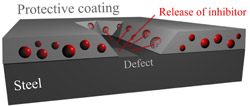Smart as skin: intelligent corrosion protection

<br>The microcapsules filled with corrosion<br>inhibitor are released when the steel<br>sheet is cut. Quelle: MPIE
Research in corrosion protection has been increasing since the 18th century, especially with respect to steel.
Galvanizing is a common protective means, but during the production process initial corrosive spots are formed right at the cut-edge. The idea that is developed at the MPIE is to incorporate microcapsules, which are filled with corrosion inhibitor, e.g. polyphosphomolybdate, into the zinc coating. As soon as the steel sheet is cut, the zinc starts to corrode and dissolve.
This is the starting shot for the intelligent, second protective system: the capsules are released from the zinc onto the steel and smeared along the surface by the cutting device. The inhibitor can be released and thus protects the steel surface.
Modification with thiols facilitates the integration into the zinc
“This is an intelligent protective system that automatically realises when and where corrosion happens, becomes active and stops again when the respective spot is healed”, explains Dr. Rohwerder, group leader in the department of Interface Chemistry and Surface Engineering. It works like a scratch in the skin: it is detected, healed and the initial status is restored.
For preparing these smart coatings, three work steps must be performed: loading of the silica microcapsules with the inhibitor, sealing them to avoid premature leaching and finally incorporating the capsules into the zinc layer.
The sealing procedure, however, has of course an immense influence on the release kinetics. By rinsing with water glass solution, the release is steady and slow. The incorporation into the zinc layer is the most difficult part. Unmodified, the hydrophilic particles are repulsed by the zinc and only adsorb on the surface.
Tabrisur Rahman Khan, a PhD student from Bangladesh, has now fixed the problem. He modifies the particles with zinc affine functional groups, such as thiols, which make the solvation feasible.
Max-Planck & Fraunhofer collaboration on intelligent corrosion coatings
Everything solved? Well, not completely. For efficient protection, a higher loading of the pores with the inhibitor must be realised. This is the focus of current research. Additionally, the concept of intelligent corrosion coatings has been expanded to systems with polymer coatings. The joint project ASKORR (Aktive Schichten für den Korrosionsschutz, active coatings for corrosion protection) is a successful collaboration between the Max-Planck and the Fraunhofer Society in this field.
Two Max-Planck and two Fraunhofer Institutes are sharing their competences with respect to nanocomposite coatings, agent containers, zinc coatings and the analysis of effective mechanisms in order to improve the protective coatings. “It is a huge challenge, but present results look very promising”, states Rohwerder.
1 Gesellschaft für Korrosionsforschung
Yasmin A. Salem, M.A.
Public Relations
Max-Planck-Institut für Eisenforschung GmbH
Max-Planck-Str. 1
40237 Düsseldorf
Germany
phone: +49 (0)211 6792 722
fax: +49 (0)211 6792 218
Media Contact
More Information:
http://www.mpie.deAll latest news from the category: Automotive Engineering
Automotive Engineering highlights issues related to automobile manufacturing – including vehicle parts and accessories – and the environmental impact and safety of automotive products, production facilities and manufacturing processes.
innovations-report offers stimulating reports and articles on a variety of topics ranging from automobile fuel cells, hybrid technologies, energy saving vehicles and carbon particle filters to engine and brake technologies, driving safety and assistance systems.
Newest articles

Parallel Paths: Understanding Malaria Resistance in Chimpanzees and Humans
The closest relatives of humans adapt genetically to habitats and infections Survival of the Fittest: Genetic Adaptations Uncovered in Chimpanzees Görlitz, 10.01.2025. Chimpanzees have genetic adaptations that help them survive…

You are What You Eat—Stanford Study Links Fiber to Anti-Cancer Gene Modulation
The Fiber Gap: A Growing Concern in American Diets Fiber is well known to be an important part of a healthy diet, yet less than 10% of Americans eat the minimum recommended…

Trust Your Gut—RNA-Protein Discovery for Better Immunity
HIRI researchers uncover control mechanisms of polysaccharide utilization in Bacteroides thetaiotaomicron. Researchers at the Helmholtz Institute for RNA-based Infection Research (HIRI) and the Julius-Maximilians-Universität (JMU) in Würzburg have identified a…



